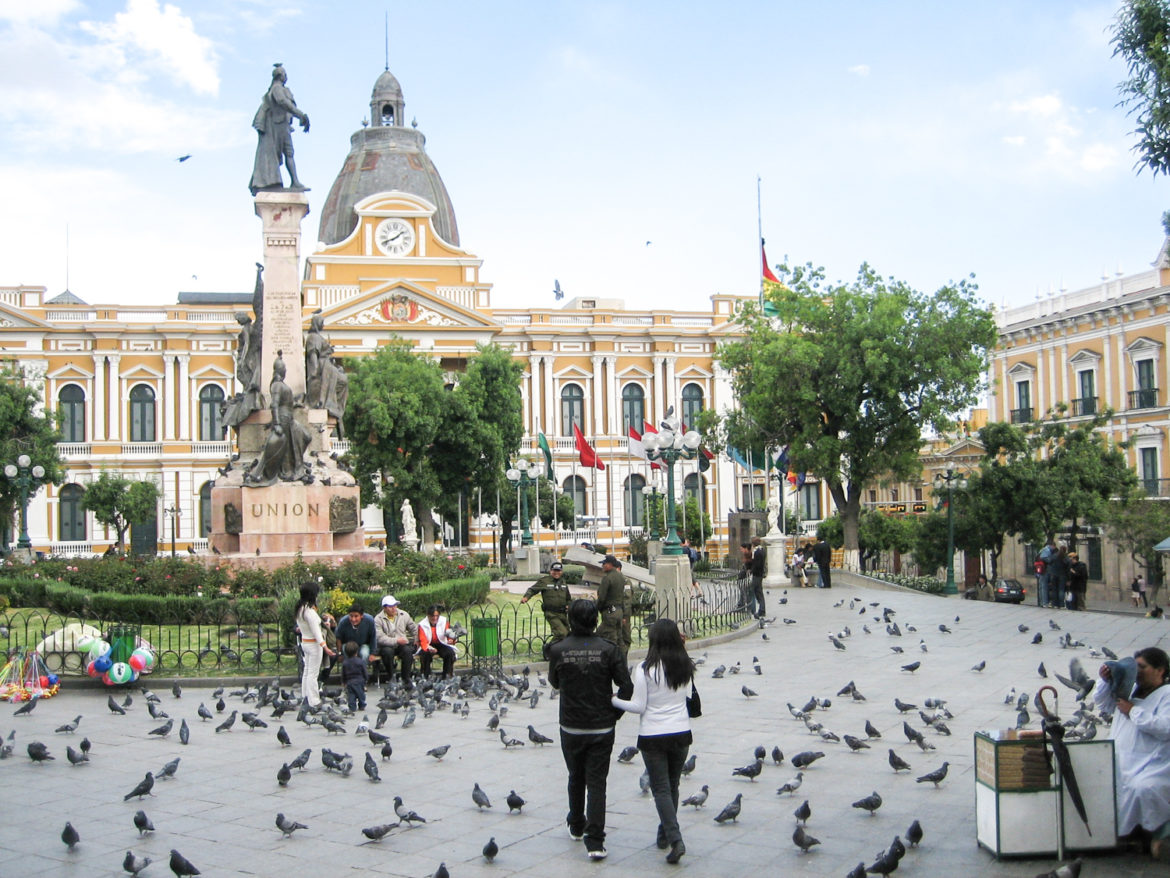Located in the Andes Mountains, La Paz is the world’s highest administrative capital at 12,000 feet above sea level.
Situated in a bowl-like valley, this colorful, crazy city is a fascinating place to visit. From Fighting Cholitas (local female wrestlers) to the House of Congress clock that runs backwards, La Paz is full of surprises.
The frenetic journey to La Paz acted as a precursor to the city itself. From Copacabana, we headed an hour east on a crowded public bus to reach the Tiquina strait. From there, we disembarked and watched as our bus got loaded onto a barge and taken across the water. Apparently, our collective weight as passengers would’ve caused the bus to sink otherwise. Instead, we crammed into the bowels of a small, motorized boat. We puttered to the other side of the shore. Once safely across, we reunited with our bus and continued on for another two hours.
As we approached La Paz, we were astounded by the massive El Alto Market. Stalls of produce, clothes and wares seemed to stretch into the horizon indefinitely. Turning a corner, the city suddenly appeared. It was like a huge crater except filled with an unfathomable amount of buildings. Arriving at the bus station, a police officer immediately approached us and advised we take a collectivo (shared community van). We later learned there had been a number of taxi cab drivers who were kidnapping American tourists for ransom (!)
After checking into a guesthouse, we kicked off our visit with Bolivia’s most popular dish: pique a lo macho.
Consisting of ridiculous amounts of fried beef, sausage, potatoes, onions, tomatoes and chilies, this is definitely a meal to share. We washed it all down with an ice cold Paceña, the national beer made with purified water from the Andes.
Fueled for the day, we set out to wander. The Mercado de Las Brujas (Witches Market) entertained us with its potions, medicinal plants and other ritualistic oddities. Dried llama fetuses were everywhere. Some locals bury them underneath their homes as a sacred offering to Pachamama, the fertility goddess of planting and harvesting.
Even everyday life in La Paz seems far from ordinary.
Scenes that caught our eye ranged from ski-masked shoeshiners to cars so loaded down, their fenders dragged the ground. In Mercado Lanza, a market-meets-mall of sorts, vendors sell everything under the sun from tiny individual stalls. Stuffed animals, housewares, fruit smoothies, flowers, cheap Bolivian street food and more. There, we met our sweet banana bread lady who we visited every day for breakfast. Just 50 cents for three huge squares of freshly baked goodness.
At the Museum of Andean Textiles, we learned about the history and craft of Bolivia’s beautiful embroidered rugs. While in pigeon-ladened Plaza Murillo, we watched Presidential Palace guards, dressed in 19th century uniforms, perform the Changing of the Guard ceremony.
In addition to our daily banana bread, we ate our fill of salteñas. These Bolivian savory pastries are filled with meat or chicken, potatoes, peas and veggies in a spicy sauce. And of course, we made sure to partake in the afternoon ritual of eating “helado” (ice cream).
In the well-to-do Sopocachi neighborhood, we made our way past trendy restaurants and pretty plazas, set against dynamic street art. One mural celebrated the cholas, the Bolivian women known for their distinct style. Dressed in bowler hats, huge shawls and multi-layered skirts, two women raised their fists in a sign of power.
But the highlight of our visit was being in town for the Day of the Dead festival.
In Bolivia’s largest cemetery, locals gather to remember, celebrate and commemorate loved ones who have passed. Entering the grounds, the endless rows of burial entombments is stunning. We watched as families congregated around the shrine of a deceased loved one. Some would leave flowers while others laid out offerings of favorite treats like tiny bottles of Coke (or beer), homemade bread and candy. Some would chant a song or say a prayer. At one shrine, there was even a Mariachi band playing a lively, yet sentimental song. At one point, an elderly woman struggled with an old rickety ladder and a vase of flowers in her arms. Brian stepped in to offer help and her gratitude came across with a huge smile. No translation needed.
On our last night, we headed to the food stalls for a cheap dinner in Plaza San Francisco. The square was packed with locals and buzzing with energy. Under the dark evening sky, the mix of glowing lights, mingling crowds and wafting smells reminded us of New York. Funny how a place that seemed so strange and unreal upon arrival was starting to feel familiar. Possibly even a bit normal.

